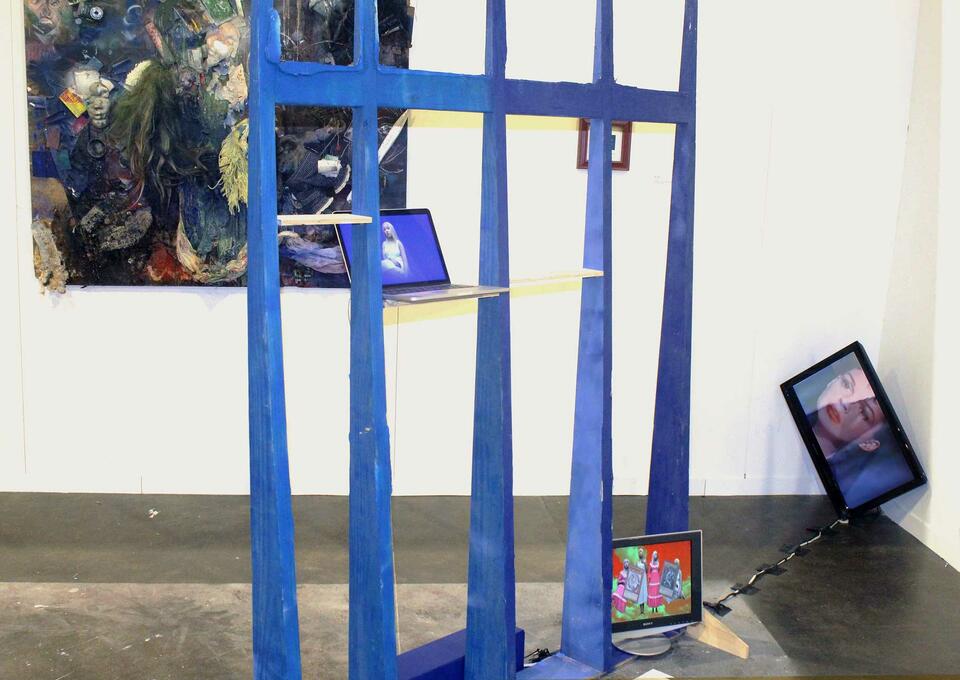Anna Glass
While We Were at Dinner
I had studied art through lectures and museum visits, culture from books and experiences, all while filling my sketchbooks with where I had been, who I had met, what I had learned, and often what I had eaten. I never thought of myself as an Artist but have found a comfortable home under the umbrella of Designer. My passion for research and an instinctive practice in visually documenting my interests and questions led me to the interdisciplinary powerhouse that is Industrial Design. I value individuality and compassion in problem-solving, and I try to approach design with humor and a bit of whimsy. I am inspired by food as a catalyst to create and nurture community, whether ephemeral or long-lasting, and I work to infuse my designs with similarly inviting qualities.
In my early journey as a designer, a theme I’ve been interested in is how I can create work to bolster community. I lean towards projects that encourage group testing and create multi-person experiences. Larger scale interventions in city parks, street corners, and community centers bring people together. They host group activities, live music, special guests, all accompanied by refreshments. School events entice participation through the promise of free snacks; even family gatherings are incentivised by the promise of a good meal. Food is always present in these community engagement activities, but it’s very rarely the main event. With that, I dialed in my research to investigate the micro communities that are, both consciously and coincidentally, formed around food. Within a dining environment the tablescape dictates the tone of a meal and signifies the expected performance of participants. Imagine how you might approach a table with three forks and two spoons at each place setting versus a picnic table with paper plates and plastic cups. We have instant assumptions of how we should act in each context, but some of these assumptions are tired and in need of an update.
Objects influence behavior, and as a designer I capitalize on this fact by manipulating environments and the adventures that go on within. Meal settings are hypernormative – governed by rules, etiquettes, and expectations that depend on where you come from and where you happen to be now. At its core a primal activity and biological necessity, there is an amazing amount of social value placed on the way we conduct ourselves around food. In my investigation of the history of dining norms, I saw an opportunity to explore and challenge these societal regulations. Global cultures are merging, and with that an explosion of fusion cuisine. However, in the context of North American dining, a spork is the only innovation I’ve seen in the realm of pioneering table tools. We are stuck deciding between chopsticks or a fork, and are afraid to be seen licking residuals from our fingers. We trust the chef opening the Korean-Mexican restaurant, and follow social media accounts that turn Kraft Mac’n’Cheese Chinese, but the way we gather and interact around these meals remains stiff. My work posits a fusion of objects: eating tools and table arrangements inspired by global cultures. My designs poke a bit of fun at the expense of the disparate rules that govern communal eating, and encourage diners to reflect on societal and self imposed regulations. Instead of crying over spilled milk, I think we should have a laugh and remember that everyone else has knocked a glass over at some point as well.
Many of us have grown up in communities and cultures where significant life events are punctuated with a meal. Ask any person about their favorite holiday and I highly suspect that their choice is based on the special food they associate with the occasion. As I’ve grown up, this trend has extended outside of my family context and has helped me to better understand and connect with people and places around the world. I've eaten with strangers in foreign countries, I've eaten in the homes of people with whom I do not share language, I've been packed lunches by women who are not my mother. The relationship is what I remember, but food is what catalyzed our connection. Many of these interactions, specifically the ones not with my own family, have happened while outside of North America. A big part of exploring new people and places is being uncomfortable, but food is a universal connector we use to share culture beyond language. We offer food to show hospitality to friends and strangers alike. And while I come from a family and culture with ingrained communal food practices, these external moments of inclusion and sharing have significantly shaped my worldview. I believe that shared meal environments, if designed in a way that promotes cultural reverence and sharing rather than restrictive hierarchies, can be an effective foundation for a world where the act of eating becomes a dynamic and transformative social experience.
The traditional notion of mealtime constitutes a daily routine of established choreography and characters. If infused with elements of surprise, it could become a time for reinvigorated interaction. As actions of hospitality and symbols of cultural pride and inclusion, the joy of overcoming an odd or awkward social environment though shared foods are tenets I promote in my design work. This shifts the focus of a meal from merely consuming food to actively engaging with others, sharing stories, and fostering connections across boundaries of personal experiences and customs. This project is inspired by cultural norms I have observed as well as those shared with me by peers and studied by experts. The way I design my dining arrangements references these traditions and the humorous outcomes of many of my own experiences. Furthermore, I invite participants to invent and navigate a new set of rules for how to eat together. I hope my work will bring people together around a shared love for food and give them a good story to take with them to their next table.
Image
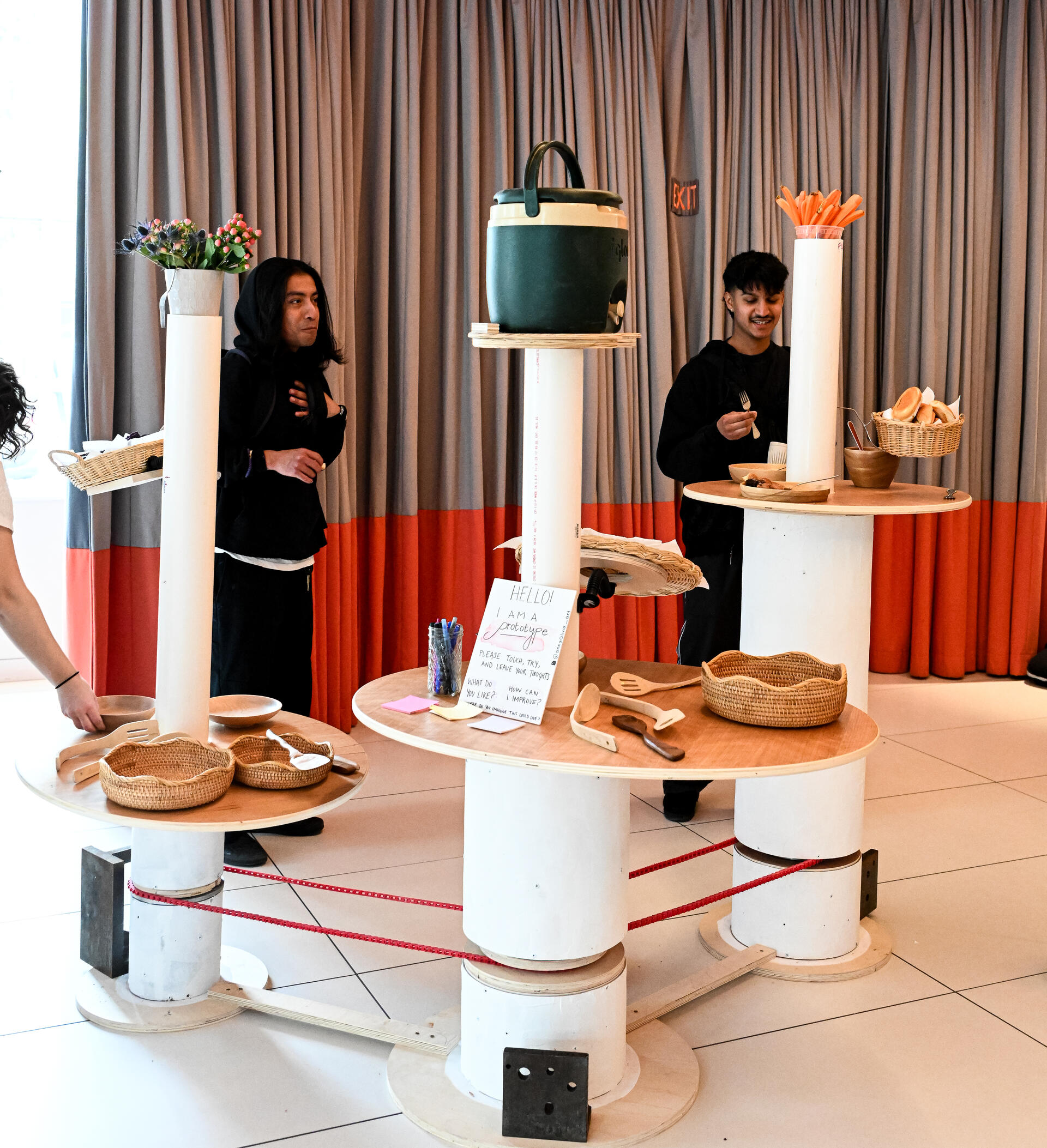
As seen in the RISD Graduate Exhibition, this three tiered turning table challenges traditional dining norms from multiple cultural and social perspectives. Made of wood, PVC pipe, metal springs, and baskets, this work invites dynamic interaction and encourages diners to create their own mealtime conventions.
Food is a versatile material and lends itself to creative experimentation. The rules of cooking are bendable, and the success of fusion cuisine is proof of how cross-cultural ingredients and techniques can push gastronomy to new limits of flavor and experience. However, while cooking grows from innovative collaboration, the tools for cooking generally stay in their prescribed lanes. Humans have invented tools for every moment of the food prepping process. As cooking techniques evolved and eating became a social event, the range of objects associated with food expanded. Not only were there tools for cooking and eating, but people developed objects specifically for the group engagement of serving and sharing. In her encyclopedic book of culinary tools and their stories, Tools for Food, Corinne Mynatt opens with a quote by author Geoffrey Warren: “To acquire even one old kitchen utensil or implement is to possess a piece of local and social history, of craftsmanship and, often, of beauty.” These tools and their evolution alongside the etiquettes of modern society do more than peel our vegetables and decorate our tables. Food-associated objects and the settings we designate for dining, in fact, have a direct impact on the way we experience eating and each other. As tools for social engagement, they are signifiers of norms, hints at expected behaviors, and physical manifestations of social convention. But what if our tools reflected the fusion we see in our food? Rather than rigid regulators, how can a new set of fusion objects facilitate a more dynamic mealtime experience?
Image
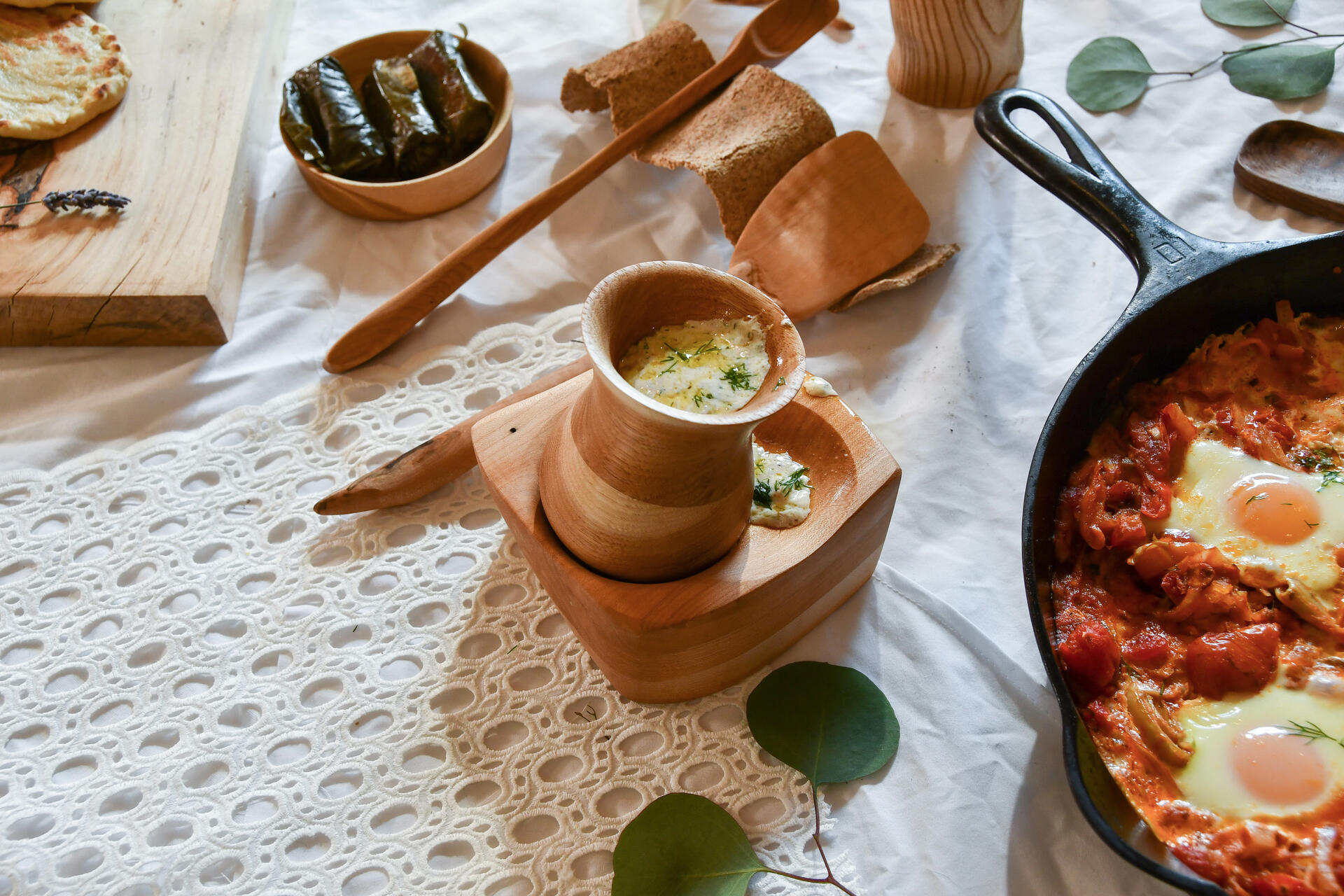
Ambiguous Implements explored form and material of creative tableware. The objects I developed drew on Mediterranean and Middle Eastern dining customs of passing, swiping, and sharing. This project was part of a six-week course taught by visiting artist Rachael Colley, with guidance from Steinbeisser Co.
A friend from college found out I was doing my masters degree at RISD and offered to connect me with another friend who had just started in the Architecture program. At that point I had been in Providence for less than a year and deep in the well of how to make new friends as an adult. Architect and I were connected via group text, and made plans to meet for lunch. We met at Small Point Cafe, a cute little coffee shop kitchen and hallmark of the RISD Grad experience. We met at the cozy little table by the window, the one with the blue velvet chairs. Having briefly exchanged names and pleasantries, we walked up to the counter to order. Our sandwiches each came in a clamshell to-go box that we brought back to our window seats. Still in the polite phase of discussing our course schedules and our mutual friend, we settled in and opened our boxes.
What happened next was a surprisingly defining moment, and I think of it as pivotal for the design of my impending schoolwork. I wonder how the architect would feel if she knew how much this next scene impacted my RISD design practice. I wonder if she even remembers what happened.
In a gesture – maybe towards her drink, something else on the table, an unconscious movement, we’ll never know – the architect leaned the weight of her arm onto the empty half of the sandwich box clamshell and cantilevered her fully loaded sandwich right into her lap. She was mortified. I was mildly amused, and mostly concerned for the fate of the sandwich.
“Oh my god, this is so embarrassing! I can’t believe this is how we’re meeting each other. I can’t imagine what you think of me.”
She went on like this; flustered, ashamed, definitely fazed.
“Oh no! Please don’t worry. I’m so sorry you’ve dropped your sandwich! Don’t be embarrassed – It’s really just a surprise that you spilled before I did.”
And I meant that.
We continued with our lunch, but there’s nothing else I could tell you about it. Only those first few minutes have stayed with me. As I replayed it over in my head, the part that would stand out is how upset she was about the impression I might have of her. In the course of our meeting, we had only just begun the process of breaking the ice. In my mind, dropping a sandwich in her lap did all of that heavy social lifting for us.
She cleaned herself up as I continued to reassure her that the spill would not deter my potential friendship. Realistically, the incident allowed us to cut through the early nice to meet you phase of lunch. Instead of more of the boring small talk, it prompted me to tell an embarrassing story of my own. It’s hard to maintain a polite facade while covered with lettuce and mushrooms and mayonnaise. It was a more interesting conversation to remind her that this kind of thing happens all the time and that I was in no way scandalized.
This lap sandwich scenario made me think about how we’ve been taught to socialize. There’s a defined order of operations – a certain threshold we must reach with a new person before we can relax a bit and be ourselves. Before we’ve reached that point, we’re discreet, calculated, careful, refined…whatever any of that means. We put our best foot forward and open up slowly, appropriately. I’ve never been very good at following these rules. Always too loud, boisterous, out there, intense. But why do we waste so much time portraying a diluted version of ourselves? Especially when sharing such an intimate activity as eating together? This incident made me wonder if we could avoid this superficial step by design. A subversive object or event may facilitate a break in this social choreography. If this break in conduct could be enabled by a designed object, that object would become a common enemy – something for the anxious socializers to rally together against, which could then facilitate a bond and encourage more open interaction.
Image
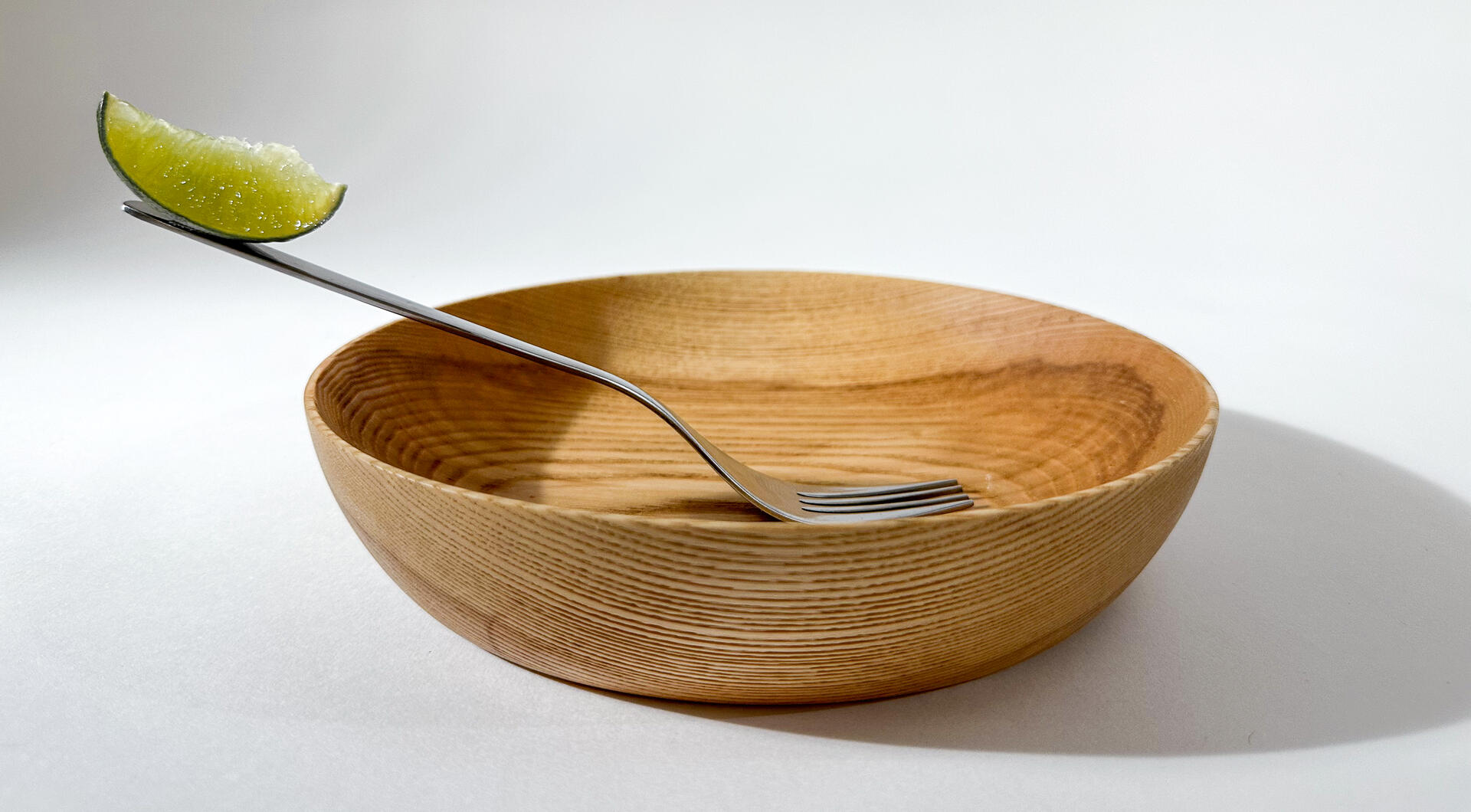
Disruptive Dinner is a collection of cups with covert holes and wooden bowls and plates with secretly embedded magnets. These quietly subversive objects were made to disrupt a potentially passive meal. In a dinner setting, these innocent plates and bowls facilitated connection between diners and reinvigorated the evening.
You’ve been formally invited to dinner at my house. You arrive, alongside others, and your host is not home. There is a sign on the door and it is unlocked: “come on up!” Everyone sheepishly files inside, and the only person there to greet you is someone you’ve never met before. She says hello and retreats back into her room. What do you do?
As you walk into the living room you see unassembled folding tables leaning against the wall alongside a set of chairs.
The coffee table has been cleared away to make space, dishes and silverware are out in a pile to the side. Food is warming on the stove, a salad is out on the island.
There are candles out with matches sitting nearby.
A bouquet of flowers sits on the floor.
Now what?
In this scenario, I’m curious to observe what people might do if they arrive at a space that’s not yet set up. They’ve arrived by invitation, on time, but contrary to the typical style of a dinner party, there is no host curating your experience - or is there? Will guests begin to construct the dining space themselves? How long will it take them to take initiative? How will they set it up? What will be the reaction once the host eventually arrives? With all of the reading I’ve done about the rejection of formal dinner parties, the goal of this experiment is to test the levels of informality and horizontality people might be comfortable with. Can invited guests take ownership of an event in a space that’s not their own?
Play by play:
[7:00] R and H arrive. Brooke greets them, I’m sitting in the
hallway
[7:01] I can hear C
[7:02] K arrives
C: Anna ran out to get something
K: yeah what was the likelihood this would be starting on time
[7:03] V arrives
V: ...something strange
Brooke is texting me that R and H are huddled in the kitchen, and C has
acknowledged that “this is kinda awkward”
I hear someone using the sink
[7:06] V [sees the camera]: “I think we are having ourselves a
dinner party”
E and S arrive
[7:08] E: Hey Anna! [the only one to call out to check if I’m around]
V: She’s not here
E: let me just put this [beer] wherever I want
Small talk
[7:10] S: So we’re hanging out at someone’s house without
them here, is that the experiment?
E: it’s like a horror movie
[7:12] Y: Did we all get the same instructions?
“Where’s Anna?” “we don’t know” “we don’t know if this
is part of it”
[7:13] They notice the food
[7:14] Discussing the doors I’m trapped behind....
Y: This feels rude, walking into someone’s house
Talking about my lateness
E suggests setting the table
[7:15] setting up the table
[7:16] M arrives
S: Did anyone try calling her and asking?
E: We’re playing into her game!
S: what if she came and we were like halfway into a dinner party
E: There is so much bait. Two candles were lit!
S organizing table
Y watering my plants
[7:20] Discussing how to properly set the table. I can hear plates
and silverware
S: She seems to have left us a puzzle
K trimming my plant
[7:23] M: I’m hungry, I came here to eat.
[7:26] L arrives
S: Anna isn’t here! She just left us materials!...this is
obviously a trap
Y: If we try to change the music will she kill us
[7:28] K: Can anybody carve a chicken?
[7:30] I emerge from my hiding spot and join the preparations happening in the kitchen. I try not to make too much of a splash and just blend in to the existing commotion. M sees me and casually asks for a larger plate. It’s anticlimactic in a very exciting way. As more people notice and giggle, they ask me where I was and if this was part of the plan. I try to play cool and just continue to help with setting the table. We all sit down for dinner and begin.
Image
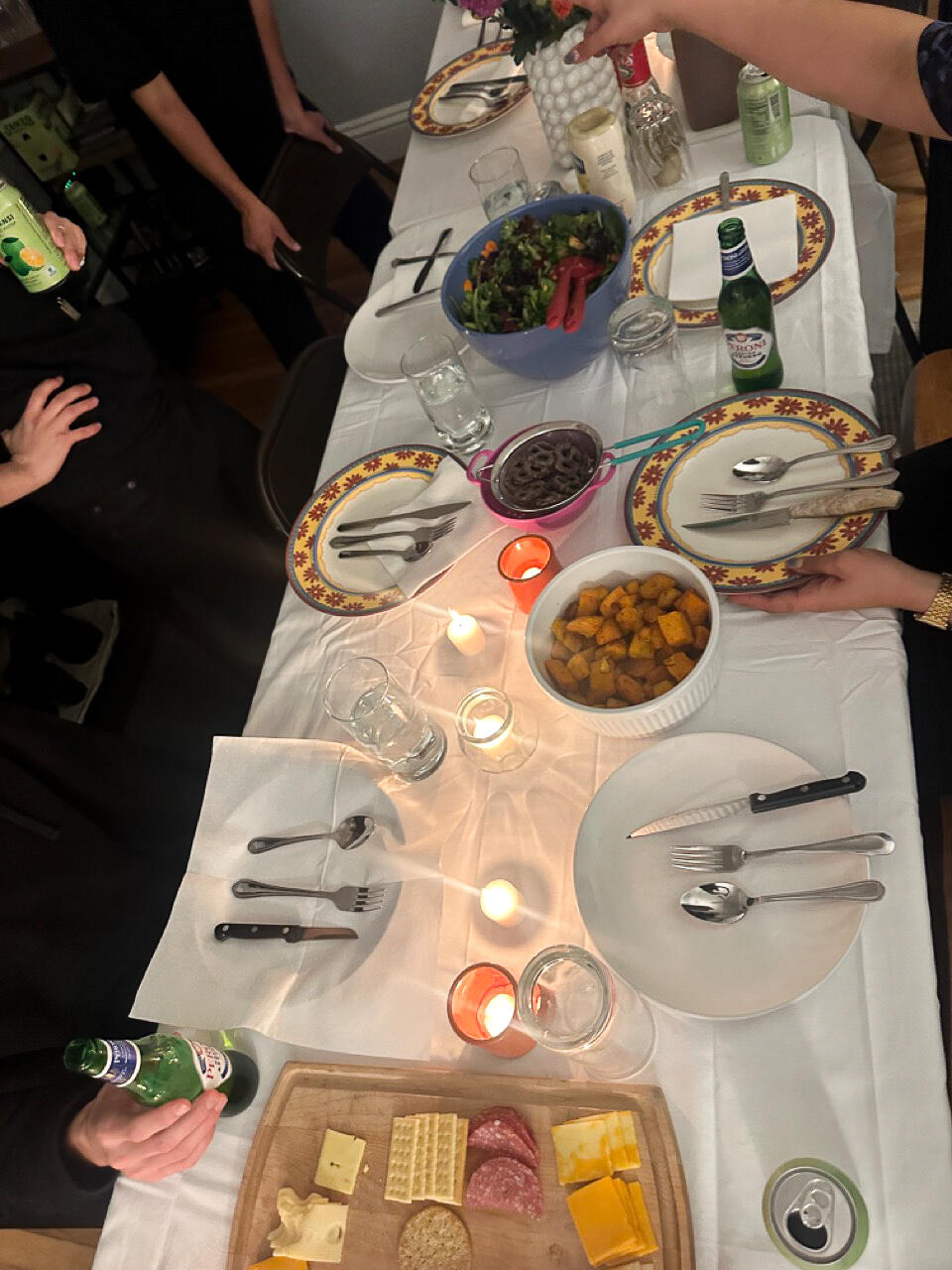
Deconstructed Dinner, a party where the host was not present when guests arrived, was a response to the hierarchies of dinner party structure. This experimental dining event tested the level of horizontality guests are realistically interested in and comfortable with when it comes to an invitation to someone’s home.
Eating outdoors on a sunny day is a joyous activity. What better way to spend a warm afternoon than sitting on a blanket in the park with your favorite food and drink arranged around you and your companions. Maybe it’s my Southern roots shining through, but the New England season for comfortable outdoor dining takes much too long to come back around. The Fifth Season, a picnic hosted in mid January, sought to bring the joys of a warm summer day to an abrasive winter.
This dining experiment was given occasion by a friend with a winter birthday. She wanted to celebrate outside, but there was snow on the ground and the sun was still setting at 4pm. We invited a third collaborator interested in indoor/outdoor relationships, and began to manufacture our own uncanny season.
We invited an eclectic guestlist, loosely connected to each other by the birthday girl, to graze on small bites on a hardwood meadow made of astroturf and inflatable pools. They were offered whole carrots and pudding cups as they stuck their feet in a patch of dirt. Toddlers and adults navigated the space with equal curiosity and enjoyed finger foods in unconventional configurations. The setting encouraged them to let go of expectations upon entering the oasis of a third floor apartment.
Image
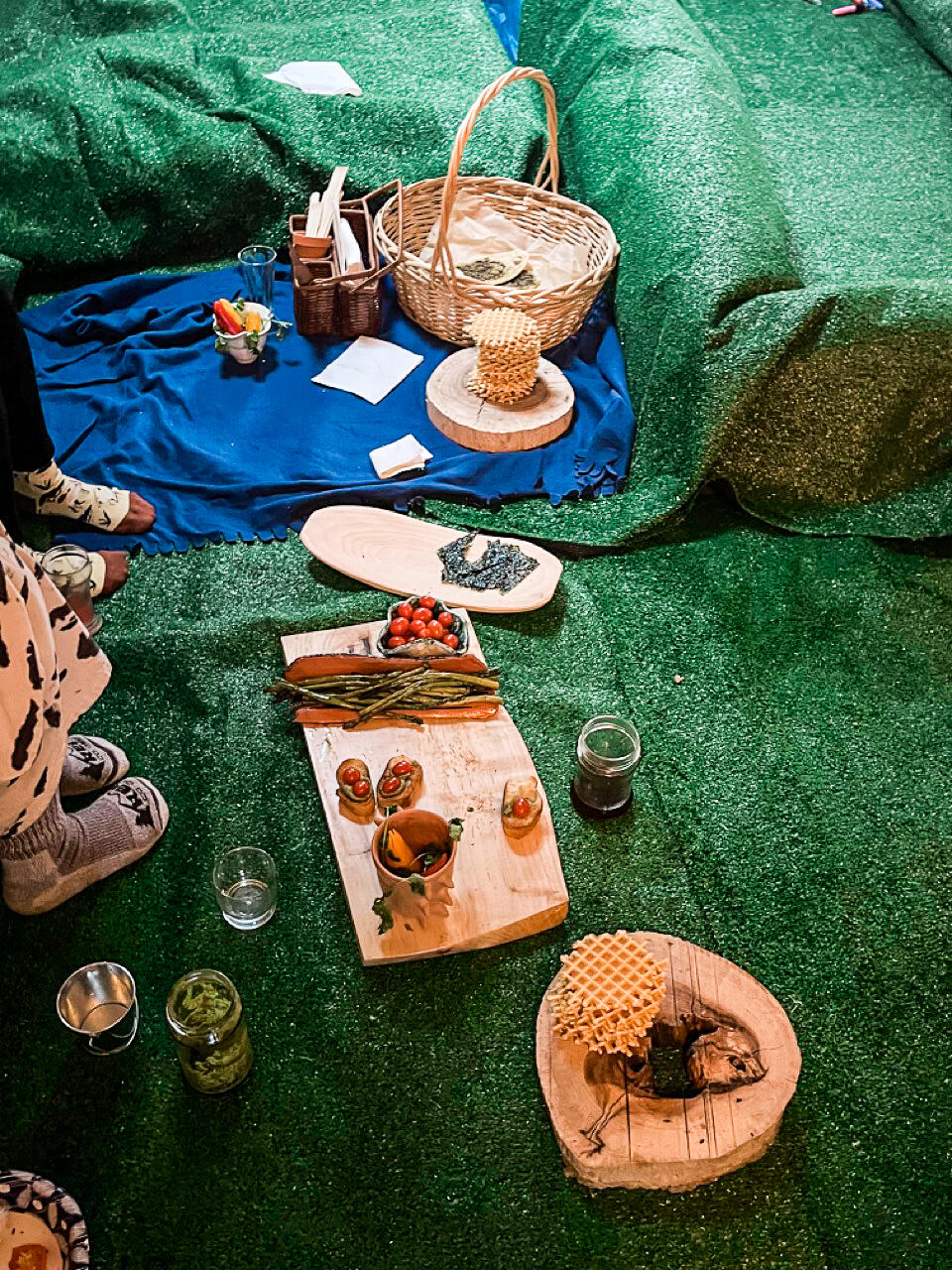
Comments such as “Why don’t we always eat like this,” and, “That’s weird, I want to try it,” rumbled through the rooms as people settled in for a January afternoon on the astroturf.
I was in London in December 2023, a semi-impulsive vacation that dropped me in the neighborhood of Islington on a Sunday morning. I lugged my bags the last half mile from the train station to the apartment, and after reading the notes Abby had left me about how to use the heat and briefly going through her closet, I decided to take myself out for a nice breakfast. There was a cute cafe just down the street called The Barn. It was much more crowded inside than the calm patisserie window display had led on, and when I asked if there was room for “just me” I was pointed toward a tiny table in the corner. I got situated at the small table and prepared myself for some A-one people watching. For about 10 minutes I watched busy waiters rush past, avoiding eye contact and in denial that there was another person waiting to order.
Eventually a man approached my table, but instead of asking what I’d like to eat he asked if I would be willing to move. My confused silence prompted him to start again with more context, and he told me that the cafe was so busy because there was an Arsenal match that afternoon (I had walked past the stadium that morning) and would I please go sit at another table with another solo woman.
“She’s a very nice lady, she comes here all the time, I really need this table.”
I was pretty shocked. I had never been asked to move tables in a restaurant before. But I figured, ok what the hell. I got up from my cramped corner table and followed the waiter to a small back room where there was a two-person table against the wall by the bathroom alcove. I rounded the table to sit across from a middle-aged woman scrolling on her phone. The waiter thanked both of us profusely, took my order, and was extra charming to the woman (I imagine to soften the blow of the uninvited stranger he had added to her morning routine).
I smiled at my new dining partner, “Hi, I’m Anna. What’s your name?”
She looked at me and hesitated. “Lindsay.”
I continued with the niceties, trying to acknowledge the strangeness of our circumstances. She timidly responded to my attempted small talk, but not without pointing out how I must not be from around here.
I consider myself a comfortable social being, but even I was a bit uncomfortable. However, I was determined to take the situation in stride, and at the very least it would be a good story for later. I talked to fill the silence, telling her all about my travel itinerary of the past 24 hours: how the train workers had been on strike that morning and I had to wait in the airport coffee shop for an hour and then the nearby station had been closed and so I had to walk farther than I had planned but it was a nice walk, and I had walked by the stadium and, oh, there was a game and was she an Arsenal fan and was she going to the game…?
She answered my questions politely, slowly warming to my company. Once we got on the topic of soccer, or rather, football, she was on a roll. She and her husband had season tickets, and their adult children would join when available. She told me how they got to know the other people who had season tickets in their same seating section, and while they didn’t get so personal as to know each other's names they would always say hello and discuss the match while in their assigned seats. I asked if anyone was joining her for the game that day, which introduced the whole new topic of selling unused tickets and that whole sub-economy of football fandom. This week she was attending the match by herself, having sold her husband’s ticket to someone online. I joked that our breakfast was practice for her next few hours of sitting next to a stranger, though I had a feeling it would be less chatty.
We each got our food, and interestingly it seemed that we had gotten the same meal but in different formats. Hers was a salad and mine was on toast, but I’m fairly certain all of the ingredients were the same. I acknowledged this lamely, and then we ate without speaking for a while. I wrote a bit in my sketchbook and checked messages on my phone. It felt rude to not engage with the other person at the table. My mom’s voice perked up in the back of my mind, telling me to put my phone down while eating, but I was trying to take a turn of letting Lindsay set the cues of our time together. Lindsay soon finished her salad and paid her check. I wished her and her football team good luck and thanked her for a lovely meal together. After she left, I sat quietly for a while trying to process what had just happened. I sketched the scene in front of me and eavesdropped on conversations about dating, jobs, family drama, sports. The meals happening weren’t just body fuel, brunch was the excuse for the social time before and between bites. I rarely go out to eat alone, and when I do I often spend the time observing the groups around me. I eventually wrote a short summary of that morning’s events in my sketchbook beneath the drawing of the restaurant space:
I arrived in London this morning. I’m staying at Abby’s flat (which I am not totally sure I know how to get back into). I took myself for brunch at the cafe just down the street and it is packed for an Arsenal football match. So packed that I was asked to move and share a table with “a very nice lady.” I said sure, and Lindsey and I had a very nice and polite brunch together. She just left for the game. What a funny way to begin this trip.
An addendum added a few days later:
I was later told that my asking her name and other small talk attempts were quite American and potentially scandalizing to this Brit.
I left the restaurant rather pleased with the strange way my trip had begun, and texted my mom “just had breakfast with a stranger lol.” She responded promptly with, “don’t tell me things like that.”
Reflecting on why this brunch with Lindsay feels so significant, I realize that the fact I agreed to move tables to sit with her was unusual in itself. Other folks I’ve shared this story with told me that they would have rather left the restaurant than sit with a stranger. To share a meal with someone is an intimate experience – think of how nervous we get for a first date, time we have agreed to spend with someone that we hope to like! To share a meal with a stranger, unplanned, unprepared for, is understandably intimidating for most. Even for me, and I’m rather good at navigating awkward social interactions, I was uncomfortable. I’ve been in objectively weirder situations, and for some reason this one stands out.
All this to say, I didn’t have a bad time. I agreed to move tables knowing full well I was in for some kind of experience – this is my thing after all. I was a willing participant, as was Lindsay (though you wouldn’t necessarily have known it). Overall, I had a very pleasant brunch and I hope she did too, and I can only imagine how the story would go from her side.
Image
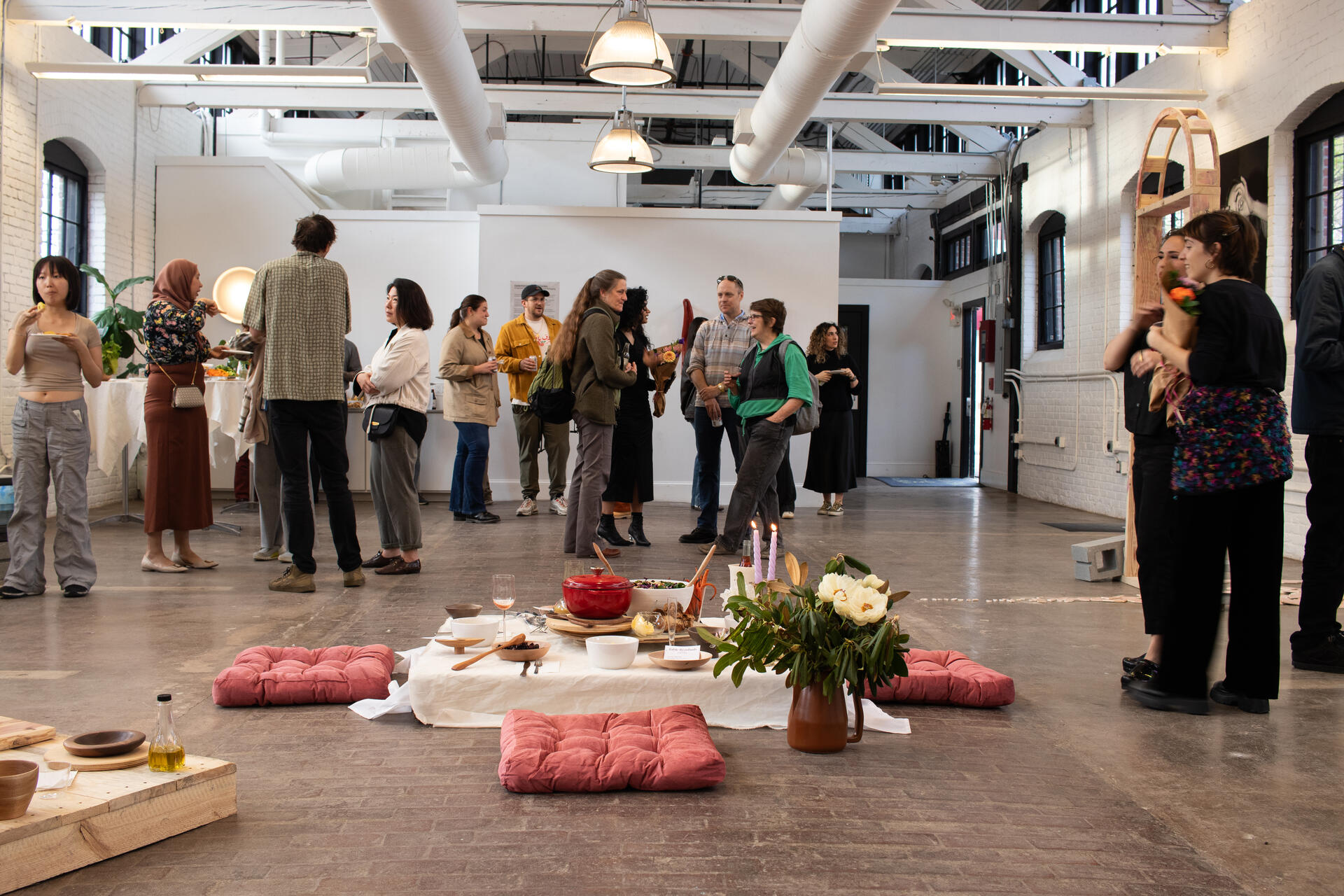
Table Residuals, a curated dinner for the artists as part of Embodied Recollections. This dining performance in a gallery setting, highlights the beauty of a communal meal, but also challenges the conventions of appropriate settings for eating and socializing.
"The act of eating is governed by a principle of absorption. The food we ingest has concrete biochemical effects in the body. This is why we literally are what we eat. But this aphorism also works the other way round – we eat what we are. Because, when we eat, we absorb not only nutrients, but also symbols and meanings. All cultures assign specific meanings to their foods – there are everyday dishes and festive dishes, main meals and snacks, things that are eaten and things that are not. Food not only weaves a web of meanings, it is also a central feature of collective and individual identities."
--Gustavo Laborde: Doctor of Anthropology, specialist in the history and culture of food, he is a professor at the School of Nutrition of the University of the Republic, Uruguay
Image

Table Residuals, a curated dinner featured in Embodied Recollections, a collaborative exhibition with four RISD MFA graduates. The temporary table was built of a shipping pallet, and the setting featured an asymmetrical turntable and utilized highly pigmented foods and with the intention of leaving a physical imprint on the tablecloth.
EXHIBITION IMAGES
